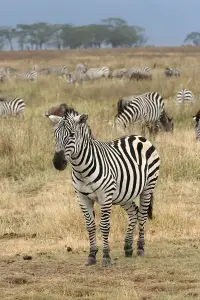Zebras are wild relatives of donkeys and horses, best known for a striking black and white stripes. Surprisingly, these elaborate markings help them blend into their environment on the African savanna by blending in with the haze of heat that occurs over long distances.

The flashing black and white of a herd of running zebras can also disorient predators. If you’ve ever wondered whether or not zebras are white with black stripes or the opposite, they are black with white stripes that cover their stomachs. No two zebras have the same set of stripes, and there are three distinct species: the plains zebra, Grevy’s zebra, and the mountain zebra.
On the African savanna, food can be scarce. Most herbivorous species migrate, but zebras often remain behind in the dry grasslands. What do zebras eat when the rains stop and all plants dry up? In zoos, zebras have the luxury of a much richer diet, but wild zebras have adapted to thrive in a land where other animals would starve. If you want to know what types of plants wild zebras eat or what they’re fed in captivity, the following sections have your answers.
What do Wild Zebras Eat?
In response to their harsh climate, zebras have evolved a highly-specialized metabolism and digestive system. They have what is known as a hindgut fermentation system, which uses helpful bacteria to digest plant fiber more thoroughly than most herbivores. This means that even if a zebra eats grasses with very little nutritional value, it can live off of them by grazing throughout the whole day. Indeed, during the dry summer months on the savanna, zebras can live off of desiccated plants that other grazers would find nearly useless.

The bulk of a zebra’s diet comes from long, flowering grasses such as Red Grass. Red Grass is one of the dominant grasses on the savanna, making it a plentiful choice for the zebra. They also eat Bermuda Grass along with riverbeds, and Common Finger Grass, which is the most widespread of the short grasses. When available, zebras eat wild legumes or beans and, during the wet season, relish the flowers and greenery as plants come to life. When grass is scarce, zebras resort to eating the roots and bark off of shrubs, such as figs, and trees like the acacia tree. Bark has almost no nutritional value, but thanks to the impressive stomach of the zebra, they can live off of it for weeks if needed.
What do Zebras in Zoos Eat?
In zoos, zebras eat very similarly to their relatives the horse and donkey. Most zoos feed their zebras timothy hay. Unlike in the wild, they only have to eat once a day, thanks to the rich nutrient found in hay. They may also be fed special pellets designed with herbivores in mind and deliver more vitamins than hay alone. Most zebras in captivity are fed a mixture of both. Another essential part of a captive zebra’s diet is a salt lick. While wild zebras have to get their salt by eating plants, captive zebras have salt blocks that they can chew on as needed.
Zebras in zoos also have access to water at all times, whereas wild zebras can survive up to five days without it. For treats, zebras in zoos are most often given carrots, although they also love the standard horse treats of apples and sugar cubes. Many zebras in captivity are friendly, and you may even find one at a petting zoo. Whether you see them in the wild on a safari or at a zoo, take a moment to appreciate these hardy creatures that survive where no other animal could.
